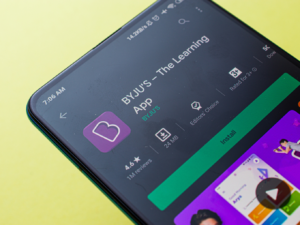Digital anthropologist Payal Arora is the author of The Next Billion Users: Digital Life beyond the West (see my book review and author interview). She grew up in Bengaluru and graduated from Harvard and Columbia. She is an Associate Professor in the School of History, Culture, and Communication at Erasmus University, Rotterdam, and will be speaking at DesignUp 2021 this month.
This year, the DesignUp 2021 conference team’s response to India’s apocalyptic second wave of the COVID-19 pandemic is to organise a virtual fundraising drive along with the stellar lineup of speakers. To be held on the weekends of June 11-20, 100 percent of donations will go to charities bringing much-needed relief to rural India, in the form of dry rations, oxygen concentrators, and health centre wards.
As media partner for the conference series, see YS’s coverage of DesignUp’s earlier online panels in 2020, May the Fourth be with you and The pandemic’s impact on design. See also our write-ups on the annual DesignUp conference editions from 2019, 2018 and 2017, and our d-Zen (‘Design Zen’) section for more design resources.
Payal Arora joins us in this chat on inclusive design, the need for better collaboration between industry and academia, and tips for aspiring designers and founders in the pandemic era and beyond.
Edited excerpts of the interview below:
[YS]: What are three outstanding examples you have seen of effective design during the pandemic?
Payal Arora [PA]: The pandemic has accelerated the growth of creative design strategies to amplify major societal issues like the undermining of care work, the rise of domestic violence, and the heightening of precarity.
The Swaddle and Aawaz are both doing ground-breaking work, the former taking on a feminist approach to these issues and the latter focusing on structural inclusion by designing their business model with the next billion users at the center.
Rest of World is another innovative media design space which has brought back slow journalism via in-depth focus and diversity in journalistic coverage, building empathies for those outside the West. These examples have in common the backbone of moral design and responsible design towards a more equitable future.
[YS]: What are the key challenges facing designers in these grim times, and how can they be overcome?
[PA]: Resource constraints and heightened competition due to the impact of COVID-19 on the economy is a big challenge.
I suggest that this is even more of a reason to find your voice and make it heard, experiment, and take risks with the audience outreach (don’t underestimate the long neglected next billion users, for instance) or formats.
Think of the Master Classes being done on Instagram for continued upskilling – check out Trupsfolio for instance. In innovative ways, she packs in nuggets of information in an edutainment style and through transmedia storytelling.
[YS]: What are some notable projects or research initiatives you are currently engaged in?
[PA]: Usha Raman at the University of Hyderabad and I co-founded FemLab.co, a future of work initiative just before the pandemic hit. Given the timing, we have been working intensely and closely with platform companies, gig workers, NGOs, activists, and government officials to ensure fair and dignified labour conditions.
The goal is to inspire designers on how to make their platforms more inclusive by rethinking the affordances and constraints of their platforms by centering the voices of low-income women workers in this process.
We have an amazing team spread out across India and Bangladesh that constitutes lawyers, sociologists, artists, designers, and media anthropologists. We have welcomed many inspiring people and organisations to work with us through this process as interns, research affiliates, and company heads. There really is a FemLab community being built and we share these voices on our weekly blog.
[YS]: What are the success factors for good designers to become good design managers?
[PA]: Let’s not assume that all designers want to take on management. It’s not a natural trajectory and nor should it be.
That said, if you remember and replicate the conditions of a healthy, creative, and supportive environment for your team that allows for irreverence and respect for ideas, you will be impactful.
[YS]: What are core skillsets or mindsets that designers need in the uncertain post-pandemic world?
[PA]: The only thing certain in life is uncertainty. Flexibility is at the heart of upskilling, re-imagining, and envisioning how we can design platforms that are resilient to seismic shifts in our social lives. It starts by thinking of the digital as not just mere tools but as vital spaces for many of us to live our everyday lives.
We need to steer design towards a healthy internet which privileges community and collaboration over that of toxic cultures that pervade online.
[YS]: Many entrepreneurs with a tech/business background tend to underestimate the importance of design. What advice would you give founders on when and how to engage with designers?
[PA]: Tech and business folk are often surprised by the “irrationality” of their customers as they defy perfectly functional and efficient systems and models.
If designers were consulted alongside, they would complement and help shape these models that are more tuned to human desire, affect, pleasure, feeling, and aesthetic – crucial for uptake and sustainability of the business models.
[YS]: What are ways in which industry and academia can collaborate to improve design education? What is your involvement in this space?
[PA]: I believe in show and tell. I am trying in my own small way to break the ivory tower mentality that has long pervaded academia.
FemLab.co is one of the ways in which we do so, as we push academics to think about the implications of their research on the actual design, development, and digital storytelling by expressing themselves in clear and inspiring terms – not the jargon that weighs ideas down and buries it in libraries.
As for designers, we work at strengthening their analytical skills – to not get swept away by merely clever tactics. Both actors are complementary and much needed in our future of education.
Payal Arora
[YS]: What are three daily habits that you think help strengthen your design sensibilities?
[PA]: I actively attend to diverse activities, topics, thinkers online outside my field – by “un-disciplining” myself, I discipline my design sensibilities.
I calm my mind with nature – I have become a big fan of kayaking regularly given I live by the water.
Don’t forget to laugh – humour always borders the irreverent and is essential for fresh design thinking.
[YS]: What are your tips or parting words of advice for the aspiring designers in our audience?
[PA]: It’s okay to be afraid. Fear can also be fuel for change – so recognise what makes you afraid, stay with it, and see if you can channel it towards a creative end. Better it be outside of you than inside for your own mental health.

![You are currently viewing [DesignUp 2021] How creative design strategies help sustainability and inclusion – Payal Arora, author, ‘The Next Billon Users’](https://blog.digitalsevaa.com/wp-content/uploads/2021/06/Payal5-1622657676484.png)

![Read more about the article [Funding alert] Healthtech startup Eka.Care raises $4.5M from angel and early-stage investors](https://blog.digitalsevaa.com/wp-content/uploads/2021/07/Imageeil3-1626672710242-300x150.jpg)




